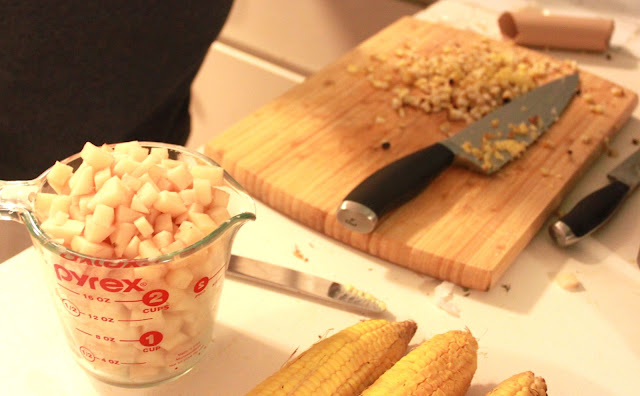The other problem was that 20 minutes of doing laundry down there was enough to send me for my rescue inhaler. You see, I'm a human mold detector; I'm severely allergic. For about 2 weeks Jeremy and I wore respirators every time we went into the basement. Big surprise that the humidity was close to 80% down there and there was mold growing on the dirt and the walls.
And here's what it looks like after a few improvements:
 The first order of business was to get the humidity down to a reasonable level. I recycled the refrigerator through Georgia Power's Earth Cents program, which is totally awesome. They pick up your old energy-guzzling second refrigerator for free and mail you a rebate check. It was $35 when I did it, but for a limited time it looks like they're offering $50. They also have all kinds of other energy rebates. (Eventually, we plan to take advantage of some for programmable thermostats and energy efficient freezers.)
The first order of business was to get the humidity down to a reasonable level. I recycled the refrigerator through Georgia Power's Earth Cents program, which is totally awesome. They pick up your old energy-guzzling second refrigerator for free and mail you a rebate check. It was $35 when I did it, but for a limited time it looks like they're offering $50. They also have all kinds of other energy rebates. (Eventually, we plan to take advantage of some for programmable thermostats and energy efficient freezers.)I also replaced an old dial-operated dehumidifier with this baby. So far it has done awesome. You can see it has the humidity down to 50% and it takes less than a day to return the basement to that level even after heavy rain. We also bought some tubing and hooked it up to the a/c pump so we don't have to empty the water manually; it's emptied through the same channel as the a/c condensation. The only downside is that with all the rain we've been having lately it ran almost continuously the month we installed it, adding about $50 to our electric bill. Ah well, it's a small price to pay to be able to breathe.
Then we cleaned the mold off the walls. Contrary to popular belief, you do NOT need bleach to do this. Bleach only kills a couple of varieties of mold on non-porous surfaces only. So, while it may be fine for a bathtub or sink it won't do jack on concrete or wood. Correcting the moisture problem and then cleaning up with soapy water (while wearing appropriate mold protection) does just as well, without the possibility of you passing out from the fumes.
 | ||
| Jeremy breaking out the debris in a settlement crack. |
I found out minutes actually means about 30 seconds once you get the cement to the right consistency, which is sort of like soft cookie dough. Once it's to that point you can roll it into a ball and really smoosh it into the crack. The water/cement ratio on the package was pretty useless though, especially after a couple of batches have made the provided scoop all gunky. I also highly recommend wearing normally-I-wouldn't-be-caught-dead-wearing-these clothes. A dust mask and gloves are also required.
|
|
So we decided to use a paint-on waterproofer on the wall and a vapor barrier over the dirt to keep mold from growing and water from evaporating into the basement air. Unfortunately, the dirt was not level and once we started digging we found out that portions of the dirt had been directly cemented over. That's actually a cement surface I'm sitting on to patch the wall. We decided the best thing to do was to build a smaller wall, perpendicular to the retaining wall to separate the dirt and concrete portions. That way we could level the dirt:
We simply hammered a few stakes in near the division and wrapped a piece of plywood in 6 mm plastic to form the wall. Then we shoveled and raked the dirt until it was level and all the mold had been turned under.
The bad part of using waterproofer is prepping the surface. For waterproofer to adhere well you have to remove as much grime and water deposits as possible from the surface your going to paint. Jeremy and I scrubbed the wall and then used masonry etcher, which is similar to muriatic acid and will eat through galvanized metals, to get rid of the deposits. The kicker is you have to flush it off the wall once it's done working, which bumped the humidity up substantially. We tried to move quick and vacuumed up the water with our shop vac.
I touched up the existing waterproofer on the foundation wall and added it to the retaining wall. The waterproofer itself is not that bad if you go with a latex base, which are a lot less smelly than oil bases and have fewer volatile organic compounds too. The waterproofer is really thick so it has to be mixed repeatedly throughout the painting process. It also has to be worked into pores and cracks, so I hand brushed the whole wall, twice.
We still have some water seepage, but the air in the basement is breathable now. In a few weeks, I'll add the vapor barrier, after Jeremy has finished rewiring. Otherwise he would just rip it up trying to get to the outside edge of the foundation wall.
All of the basement mold and moisture problems stem from the fact that way too much water makes it close to the foundation because our lot slopes toward the house. But I am a woman with a plan! Stay tuned for more on correcting drainage issues.











